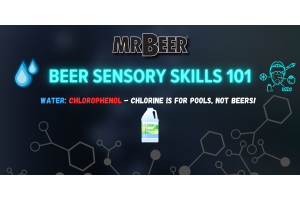How is Hopped Malt Extract Made?
Hopped Malt Extract is at the base of everything that we do at Mr. Beer. If you brew with Mr. Beer you will always use hopped malt extract. How is it made exactly? The process behind the scenes is not well known so we wanted to break it down for you.
It’s a common misperception that most people think Hopped Malt Extract (HME) is somehow different form brewing with all grains. That you are using an inferior product and you will not get the same results with your homebrew by using HME instead of grain.
This could not be further from the truth.
What HME is does for you is shortens your brew day from 6 to 8 hours down to 1-2 hours at the most. You are not giving up any of the quality or taste in your finished product. The process is the exact same as brewing with all grains, you are just saving time.
Before we dive into how HME is made let’s talk about where ours is made.
We are owned by Coopers Brewery. They are based in Australia and are the largest provider of malt extract for home brewing in the World. Cooper's got into home brewing products in 1977 and they started canning hopped malt extract in 1984. Cooper's oversees the entire production process from the malting of the grains to putting the hopped malt extract into the cans. It is a fully automated system from start to finish and it helps ensure that, the end user is getting the best quality HME, and the freshest product that is available.
Fun fact, in November 2017, Coopers opened a $65 million maltings plant at the brewery. It's one of the most state-of-the-art malting facilities in the world. It's all stainless steel and a fully automated maltings plant. This allows Coopers greater control over the entire process. From getting the raw grains to canning the HME.
The first step in making HME is the malting of the grains. Malting is a three-step process.
Step one is steeping. This is where the raw barley is transferred to the steeping house and is submerged in water. The steeping process is over when the barley reaches a moisture level, that will allow the starches and proteins to breakdown at the same rate.
Step to is germination. This is where you're taking the steeped barley and transferring it to the germination vessels where it'll be in the process of what would normally be sprouting. The proteins and carbohydrates of the grain begin to break down, which causes the grain bean to open. This process is controlled by temperature and moisture that is pumped up from the bottom of the grain bed. The bed of grain is consistently being turned over. This helps prevent clumping during this process.
The germination vessel looks like a large round container. The bed of the vessel where the grain lies is made of up little holes which will push the moisture up though the grain bed.
Step three is Kilning and this stops the germination process. If you did not stop this process, your grain would just turn into a plant. Depending on the type of malt that is being made, the kilning time and temperature can vary. The goal for this process is to take moisture out of the grain. This is usually done in a three-stage process and each process is at different temperatures for different amounts of time depending on what type of malted grain you are trying to make. This is also important because it helps ensure that the enzymes remain intact to be used during the mashing process.
Just like with germination, during the kilning process the hot air is coming up from the bottom and rising through the grain bed. Coopers uses heat exchangers as well, so they are recirculating the hot air through the grain bed
That 3-step process was just the first step in the process of creating hopped malt extract. At this point now, the brewery has made malted barley. This is the base for any type of homebrew recipe that you are trying to make. Once the malting process is over the malted grain is then stored malt storage silos until it is ready to be used.
When Coopers is getting ready to start a brew that is when the malted grain will be removed from the storage silos. Once they take it out of the silos the entire process is automated and takes about 6 hours to complete and finished with them putting the HME in cans on their automated canning line.
The grain will be transferred from the malt storage and is run though a mill which will break up the grain for brewing. After it runs through the mill it is transferred to the Mash Tun. The Mash Tun is filled with heated water and the heated water will help the enzymes convert the starches into fermentable sugars. Depending on the makeup of your grain bill this will determine what kind of beer you're brewing. Stouts and Porters are going to have more darker roasted malt, while lighter colored beers would have more lighter malts.
The mashing process will hold a constant temperature of 148F-154F and this step can take a few hours to complete. Once the mashing is complete the liquid is sent though a filter that will remove the spent grain.
Now what you have is your pre-boiled wort and after it goes through the filter it is transferred to the Brew Kettle.
In the Brew Kettle is where all the hop addition is done and boiled for bitterness and aroma, depending on the style of beer that is being brewed.
After the Brew Kettle the mixture is transferred to the whirlpool. This process is used to help remove any hop residue that might be left over from the boiling process.
Now, all of the steps that we have gone through are the exact same for brewing with all grain. This is also the same process that is used in breweries all over the world.
After the whirlpool the wort will be split. Some will go to the fermenters where it will be brewed and bottled into Coopers Beer. The other part will go into an Evaporator.
Coopers uses a centrifugal evaporator that removes the water without the use of any additional heat. During this process about 80% of the moisture in removed and you are left the syrup like substance that you get in your cans of extract.
The unique thing about this process is the fact that Coopers does not add any heat to extract the water. Adding heat to Hopped or Unhopped Malt extract can darken and reduce the quality. This is what set’s Coopers & Mr. Beer’s Hopped Malt Extract apart from everyone else.
Once the moisture level is where it should be the liquid (which has a syrup like consistency now) is transferred over to the canning line where it is packed and ready to go.
The process of creating HME is the same as brewing from all grain. With the method that Coopers uses, you are getting the best quality malt extract and saving 6 hours on your brew day. You are not brewing an inferior beer or not “truly brewing”. Using Hopped Malt Extract saves time on your brew day (4-6 hours), helps with consistency during brewing and just makes amazing homebrew.





